Welcome to our comprehensive guide on growing and caring for broccoli in India, your go-to resource for cultivating this nutritious and versatile vegetable. Whether you’re a seasoned gardener or a green thumb enthusiast, this step-by-step guide will walk you through the entire process – from planting the seeds to a bountiful harvest. Discover the best practices, essential tips, and regional considerations tailored to the Indian climate. Embrace the joy of homegrown broccoli and elevate your culinary endeavors while promoting a sustainable lifestyle.
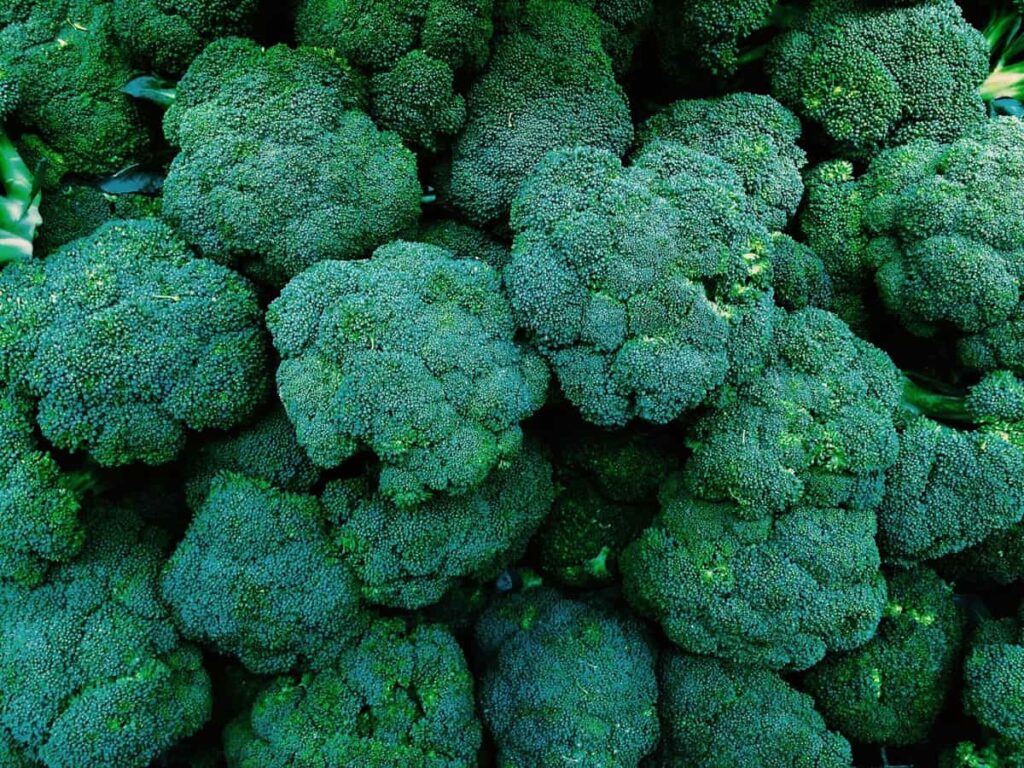
How to Grow and Care for Broccoli in India
Fascinating Biology of Broccoli
Broccoli, a Brassicaceae family and genus member, is a cool-season crop suitable for temperate climates in India. Its edible flower heads consist of densely packed blossom blooms. The name “broccolo” is from the Italian word “broccolo,” meaning “cabbage sprout.” The life cycle of broccoli starts with seed germination and seedling development, culminating in a central crown.
After harvesting, smaller side shoots are produced, extending the harvest period. Broccoli’s adaptability to various growing conditions and rich nutritional profile makes it a fascinating subject for agricultural scientists and horticulturists worldwide. As broccoli gains popularity in the Indian vegetable market, producers and consumers will benefit from its delicious and nutrient-rich addition to their diets.
Best Broccoli Varieties for Indian Climate
Selecting the right broccoli varieties for the Indian climate is vital for successful cultivation. While traditional varieties like ‘Green Magic’ and ‘Green Duke’ are heat-tolerant and adaptable, the Italian ‘Calabrese’ also thrives in Indian conditions. ‘Early Dividend’ is an excellent choice for regions with shorter growing seasons due to its fast growth and early harvest. Additionally, ‘DeCicco’ offers continuous side shoot production, ensuring prolonged yields.
- Roylegreen: This variety is known for its large, dark green heads and its resistance to bolting.
- Evergreen: This variety is also known for its large heads but is more tolerant of heat than Roylegreen.
- Danube: This variety is a good choice for cooler climates, as it is resistant to frost.
- Yugren: This variety is a fast-growing broccoli ready to harvest in about 60 days.
- Salinas Pilgrim: This variety is good for spring and fall planting.
These varieties can be grown in India, but they need suiting for the cooler regions of the country. They all produce large, tasty heads of broccoli, and they are all relatively resistant to pests and diseases. These varieties not only withstand warm temperatures but also boast robust flavors and nutritional value, making them perfect choices for Indian home gardens and commercial farms alike.
In case you missed it: Advancing Sustainable Agriculture through Germany Greenhouse Farming
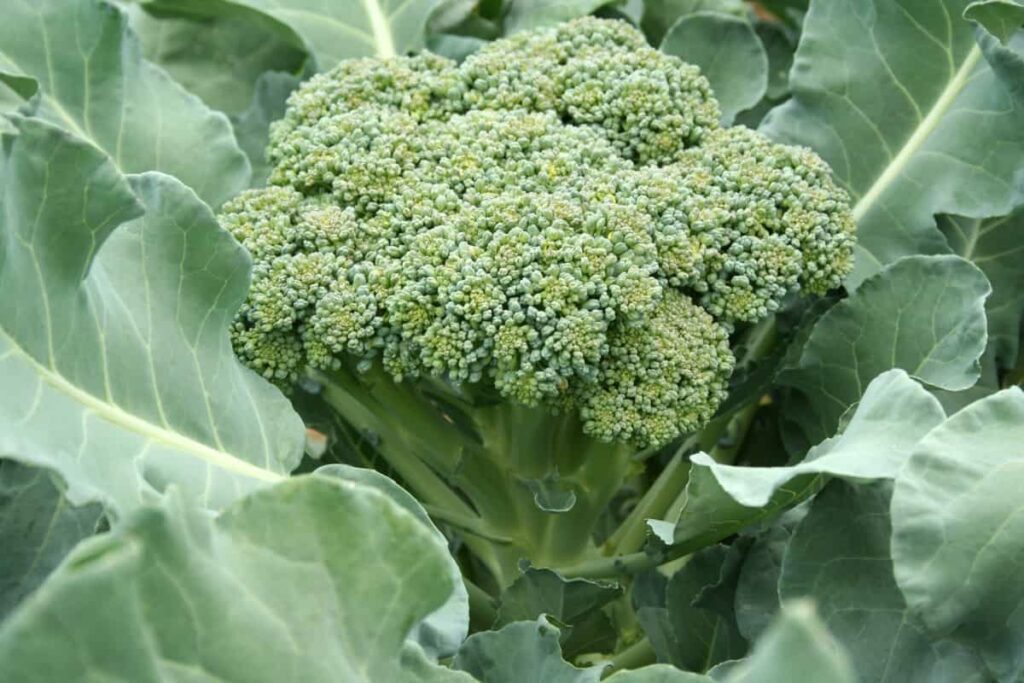
Ideal Soil Conditions for Growing Broccoli in India
Broccoli thrives in well-draining, loamy soils with a pH range of 5.8 to 7.0. These soils ensure proper aeration, root development, and nutrient absorption. Enriching the soil mixture with organic matter, such as compost, and manure, enhances its fertility, structure, and moisture-holding capacity. Sandy soils can be amended with organic matter to improve water retention, while clay soils benefit from added compost to enhance drainage. Testing the soil’s pH and nutrient levels before planting allows for precise adjustments, ensuring an ideal growing environment for broccoli.
Optimal Temperature Requirements for Broccoli Cultivation in India
Broccoli prefers cool temperatures for optimal growth. The ideal temperature range for its cultivation is between 17°C to 24°C. In regions with milder winters, 14°C to 20°C temperatures are also suitable. While broccoli can tolerate brief periods of lower temperatures, it may bolt prematurely in prolonged heat or extreme cold. Adequate temperature control through proper planting times and positioning can help Indian farmers achieve the best results with this cruciferous vegetable.
How to Prepare the Soil for Broccoli Planting in India
First, clear the field of weeds and debris to create a clean planting area. Next, use a plow or tiller to loosen the soil to a depth of at least 20-25 cm, ensuring soil proper aeration and root penetration. Incorporate well-rotted compost or organic matter into the soil to enhance its fertility and structure.
Conduct soil testing to determine nutrient levels and make necessary adjustments. Incorporate well-rotted compost or organic matter into the soil to improve its structure, fertility, and moisture retention capacity. Add fertilizer with higher nitrogen content, like 10-10-10, can be added before planting to promote vigorous vegetative growth.
When to Sow Broccoli Seeds in Different Regions of India
For northern regions of India, where winters are colder, it’s best to start sowing broccoli seeds indoors during late summer to early fall. This allows the seedlings to establish themselves before transplanting them outside. In southern regions with milder winters, broccoli seeds can be sown directly in garden soil during the winter.
- North India: Mid-August to mid-September
- Central India: Late August to early October
- South India: Early September to late October
- East India: Mid-August to mid-September
- West India: Late August to early October
In areas with mild winters, late fall is suitable for direct seeding. Local climate and its impact on the plant’s growth cycle.
In case you missed it: Revolutionizing Agriculture: The Rise of Greenhouse Farming in France
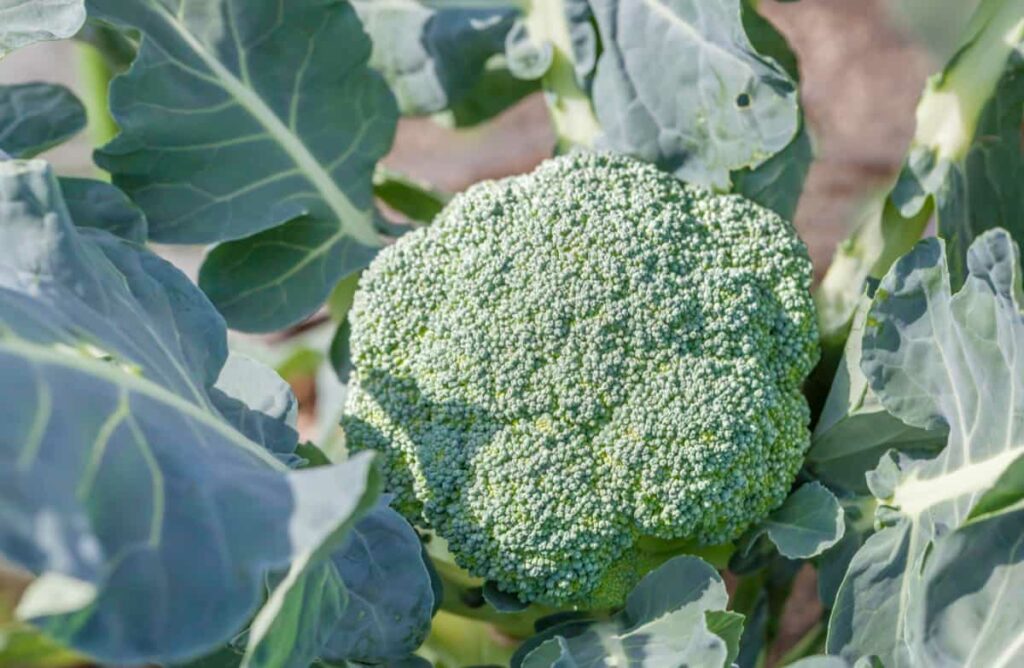
Proper Spacing and Planting Techniques for Broccoli in India
When planting broccoli seedlings, space them 18 to 24 inches apart in rows spaced approximately 24 to 36 inches apart.
- Spacing: Broccoli plants need plenty of space to grow, so they should be spaced 45-60 centimeters (18-24 inches) apart.
- Planting depth: Broccoli seeds should be planted 1-2 centimeters (0.5-1 inch) deep.
- Planting: Direct seeding or transplanting seedlings are viable planting methods for broccoli.
Adequate spacing provides enough room for the plants to grow without overcrowding, allowing air circulation and reducing disease risk. Plant the seedlings at the same depth as their nursery containers, and water them thoroughly after transplanting.
Watering Requirements for Broccoli Plants in Indian Conditions
Broccoli plants require consistent and even moisture throughout their growth stages. Adequate water intake ensures proper nutrient absorption and supports healthy plant development. On average, broccoli plants need approximately 1 to 1.5 inches of water to week through rainfall or irrigation. However, avoid overwatering, as waterlogged soil can lead to root rot and other water-related issues. Applying mulch around the plants helps retain soil moisture, suppress weeds, and maintain an optimal soil temperature.
Fertilizer Recommendations for Growing Healthy Broccoli in India
Broccoli plants require consistent and even moisture throughout their growth stages. Adequate water intake ensures proper nutrient absorption and supports healthy plant development. Broccoli plants need approximately 2 cm of water through rainfall or irrigation. Broccoli requires a balanced nitrogen fertilizer at 2 pounds per 100 square feet of bed each month for growth.
Phosphorus fertilizer (P-K 10-30) is crucial for 1 pound per 100 square feet of bed growth. Potassium fertilizer (K-20) improves broccoli’s flavor. However, avoid overwatering, as waterlogged soil can lead to root rot and other water-related issues. Applying a layer of mulch around the plants helps retain soil moisture, suppress weeds, and maintain an optimal soil temperature.
In case you missed it: Revolutionizing Agriculture: Exploring Morroco Greenhouse Farming
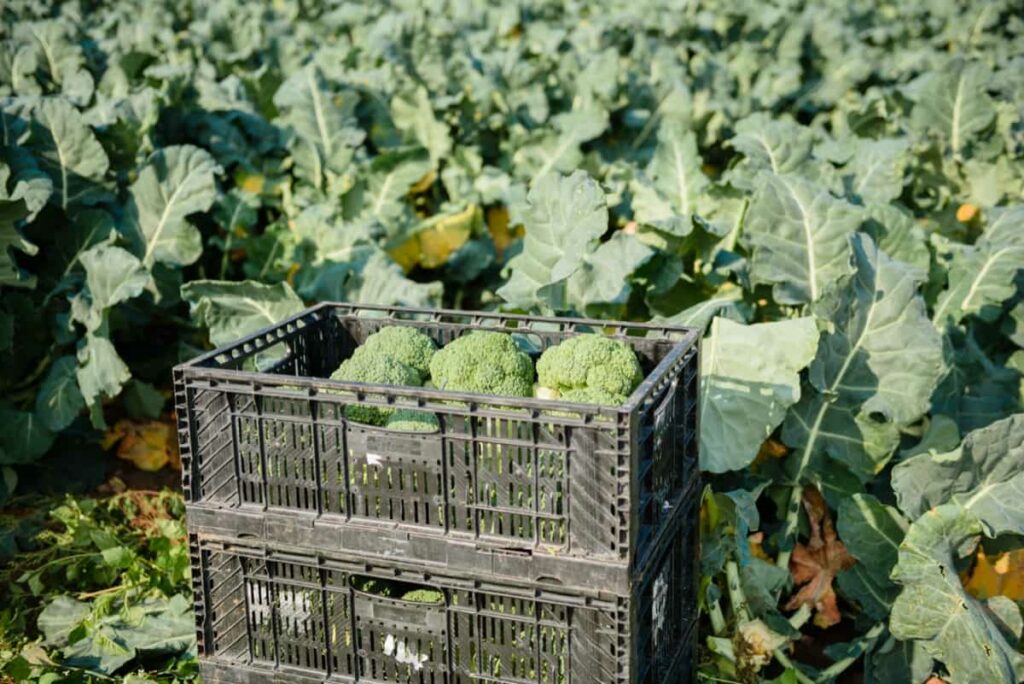
Common Pests and Diseases Affecting Broccoli in India
Common pests include aphids, caterpillars, and diamondback moths, which can cause substantial damage if uncontrolled. Diseases like clubroot and black rot can also threaten broccoli plants. Regular monitoring and early detection Inspect your plants regularly. Remove any infected or infested plants. Plant-resistant varieties. Use insecticidal soap or neem oil. Apply a fungicide.
Pests
- Diamondback moth
- Flea beetle
- Cabbage looper
- Thrips
- Aphids
Diseases
- Damping off
- Clubroot
- Alternaria leaf spot
- Black rot
- Downy mildew
- White rust
Organic Methods to Control Pests and Diseases on Broccoli Plants in India
Organic pest and disease control methods are essential for maintaining a healthy, chemical-free broccoli crop. Organic solutions like neem oil, garlic spray, or insecticidal soap can control common pests without harming beneficial insects. For disease management, crop rotation and soil drenching with copper-based fungicides can effectively prevent and control diseases like clubroot and black rot. Introducing beneficial insects like ladybugs and maintaining overall plant health through proper care are essential components of an organic pest and disease control approach.
Pruning and Training Techniques for Better Broccoli Yields in India
Once the main head reaches maturity, it should be cut at an angle to promote the development of side shoots. Regular harvesting of side shoots ensures continuous production throughout the growing season. Stocking or using trellises to support the heavy heads also prevents breakage and damage.
- Side-shooting involves removing the side shoots that develop from the main stem. This will help to focus the plant’s energy on producing a large, central head.
- Flowering: Once the central head is harvested, you can encourage the plant to produce more side shoots by pinching off the flower buds.
- Training: You can train broccoli plants to grow in a single upright stem by tying them to a stake or trellis. This will help prevent the plants from toppling over and improve air circulation, which can help prevent pests and diseases.
In case you missed it: Exploring the Innovative Techniques of Australian Greenhouse Farming
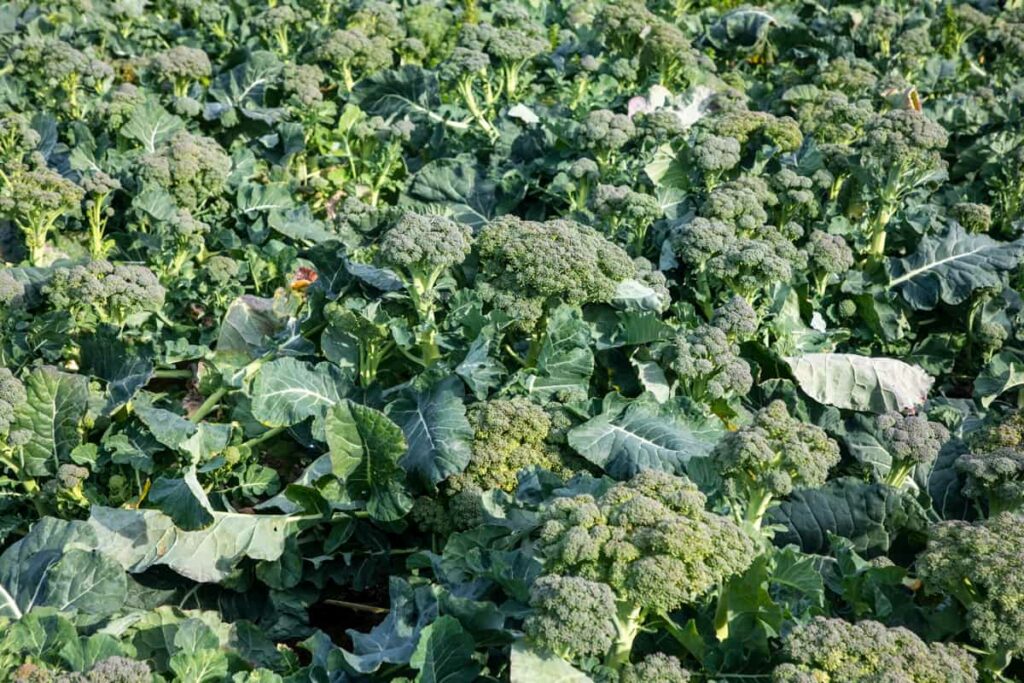
Harvesting Indicators and Techniques for Broccoli in Indian Gardens
Harvest broccoli heads when they reach full size, tight, compact, and before the buds open. Cut the central head with a clean, sharp knife at an angle to prevent water accumulation, which can lead to rot.
Harvesting Indicators
- The head should be tight and green.
- The florets should be small and tightly packed.
- The stem should be firm and crisp.
Harvesting Techniques
- Use a sharp knife to cut the head of broccoli off the plant.
- Leave about 5 centimeters of stem attached to the head.
- Harvest the broccoli when the weather is cool.
- Regular harvesting of side shoots promotes continuous production and extends the harvest period.
Storing and Preserving Harvested Broccoli in Indian Households
Proper storage and preservation techniques are essential to retain harvested broccoli’s freshness and nutritional value in Indian households. To store broccoli, refrigerate it in a perforated plastic bag to maintain its moisture without causing condensation. Properly stored broccoli can remain fresh for up to a week.
Blanching and freezing are effective methods for long-term preservation. Briefly immerse the florets in boiling water to blanch the broccoli, then transfer them to ice water to halt the cooking process. After blanching, pack the broccoli in containers or freezer bags and store them for later use.
Companion Planting Options for Enhancing Broccoli Growth in India
Companion planting involves strategically placing plants that benefit each other when grown together. Companion plants like thyme, dill, and chamomile for broccoli can help deter pests and attract beneficial insects. These herbs act as natural repellents, reducing the risk of pest infestations.
Planting broccoli alongside other brassicas like cabbage and cauliflower can create a mutually beneficial environment, as they have similar growth habits and nutrient requirements. Companion planting maximizes garden space, enhances soil health, and promotes better overall growth for broccoli in Indian gardens.
Tips for Successful Container Gardening of Broccoli in Indian Urban Areas
- Choose Compact Varieties: Opt for compact broccoli varieties in limited urban spaces for container gardening. Varieties like ‘DeCicco’ and ‘Waltham 29’ are ideal choices.
- Select the Right Container: Use large containers with proper drainage holes to prevent waterlogging. Containers made of plastic or clay are excellent choices.
- Sunlight is Key: Place your containers in a location that receives at least 6 hours of sunlight daily. Adequate sunlight is essential for healthy plant growth.
- Quality Soil Matters: Use a high-quality potting mix with good drainage properties. Mixing compost with the soil enhances fertility and moisture retention.
- Water Regularly: Broccoli requires consistent moisture. Regularly water the containers to moisten the soil, but avoid overwatering to prevent root rot.
- Fertilize Appropriately: Apply a balanced, slow-release fertilizer to provide essential nutrients for robust growth. Follow package instructions for proper dosage.
- Watch Out for Pests: Monitor for pests like aphids and caterpillars. Introduce natural predators like ladybugs or use organic pest control methods if needed.
- Prune and Harvest: Trim yellowing leaves and prune the central head after maturity to encourage side shoot production. Harvest broccoli heads when compact and tight.
- Support Heavy Heads: Stake or use trellises to support the heavy broccoli heads and prevent breakage.
In case you missed it: Hydroponic Saffron Farming: Cultivating Premium Saffron through Modern Techniques
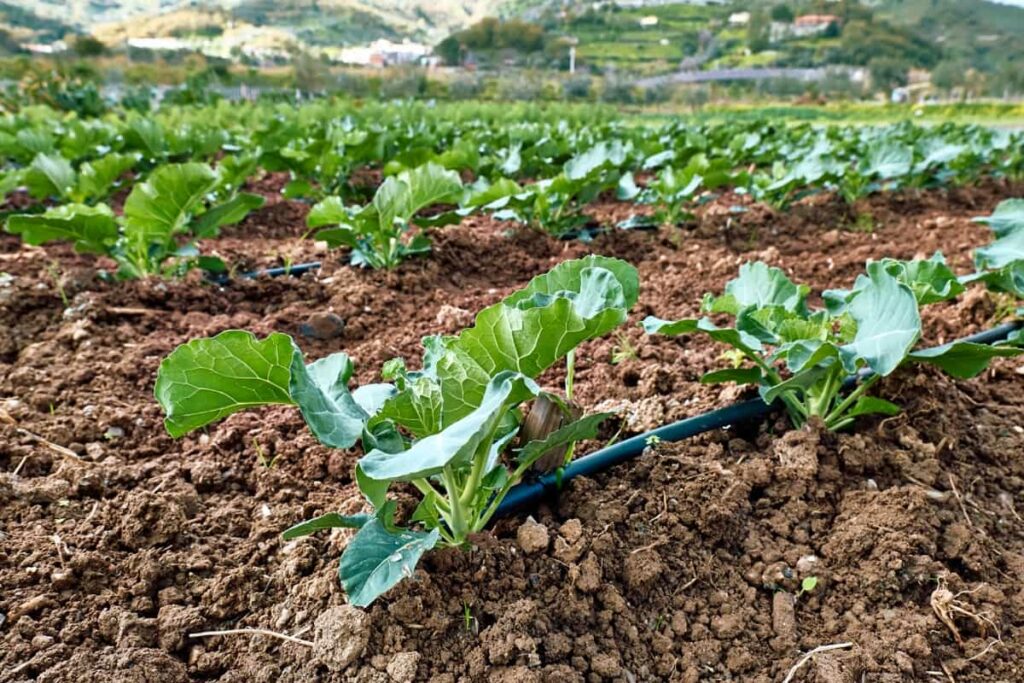
Conclusion
Growing and caring for broccoli in India can be a rewarding and fulfilling experience. Following our step-by-step guide, from planting the right varieties to nurturing the plants through proper watering, fertilizing, and pest management, you can enjoy a successful harvest of this nutritious and versatile vegetable in your home garden.
- Aquaponic Farming at Home: A Step-By-Step Guide
- Profitable Village Farming Business Ideas in 2024
- High-Yield Aquaculture: Fast-Growing Fish for Farming
- Effective Fish Pond Construction Techniques for Beginners
- Irrigation and Water Management in Pineapple Farming
- Blossom to Harvest: Mastering Flowering and Pollination in Papaya Farming
- Pig Fattening Essentials: From Selection to Sale for Beginners
- Raising Wagyu Cattle: A Complete Guide for Premium Beef Production
- Soil Types and Their Water Holding Capacity
- Optimizing Irrigation Schedules for Coconut Groves for Enhanced Yield
- Espresso Your Garden: Coffee Grounds for Healthier Acid-Loving Plants
- The Best Soil Mix for Snake Plants: How to Mix Your Own Snake Plant Soil
- Green Thumb Success: Expert Tips for Cultivating Greenhouse Beans All Year Round
- Bloom All Year Round: The Ultimate Guide to Indoor Hyacinth Care
- Eco-Friendly Gardening: How to Make Liquid Fertilizer from Kitchen Waste
- Ultimate Guide to Grow Anise in Pots: Explore Seed Propagation to Harvesting
- Guide to Raising Chester White Pigs: Discover Breed Facts to Growth Management
- Mastering the Elegance: The Ultimate Guide to Weeping Cherry Tree Care, Planting, and Maintenance
- Ultimate Guide to Planting Garlic in Grow Bags: Growing Strategies for Beginners
- How to Fix Spider Plant Leaf-Related Problems: Natural and Organic Remedies
- 10 Reasons Why Your Tulsi Plant is Shedding Leaves: Home Remedies and Solutions
- Optimizing Growth and Yield: The Advantages of Palm Bunch Ash Fertilizer
- Utilizing Neem Oil Extract as a Natural Pesticide for Hydrangea
- From Soil to Harvest: Various Ways in Which Farmers Can Use AI Tools
- Steps to Encourage and Induce Citrus Flowers: A Comprehensive Guide
- How to Fix Snake Plant Leaf-Related Issues: Natural and Organic Remedies
- Transform Your Garden into a Fragrant Oasis with Raat Ki Rani (Night Blooming Jasmine)
- Discover the Ideal Chicken Breeds for Philippine Farms
- How to Create a Poultry Egg Farm Business Plan for Profits
- Grow Lemon Cucumbers Like a Pro: Insider Techniques for Bountiful Yields
- Ultimate Guide to Caring for Your Pink Princess Philodendron: Tips for Thriving Variegation
- Areca Nut Profit Per Acre: Calculating Yield and Cost of Cultivation
- How Kaveri Chicken is Becoming a More Profitable Breed in Indian Backyards
- Transform Your Barn: 9 Steps to Convert a Horse Stall into a Chicken Coop
- Exploring Suffolk Sheep Disadvantages with Limitations and Challenges
- Guide to Solving Potted Lemon Tree Problems: How to Revive Lemon Tree in Containers
